Beef Cattle Handling Facilities
Purposes of Handling Facilities
Good cattle handling facilities are necessary for all cattle operations, regardless of the number of cattle. Cattle handling facilities are used to restrain individual animals during management practices (vaccinations, health treatments, pregnancy diagnosis, etc.). Good facilities help cattle handlers collect performance data, which is critical to herd genetic improvement and marketing efforts. These facilities can be as rudimentary as a rope used to restrain a calf in an open pasture or as complex as a transportable set of pens and hydraulic chute.
There are several important issues to consider when developing new, or renovating existing, animal handling facilities. The most important consideration is the intended uses or objectives. Consider whether the facility will be used to handle 30 cows and calves just a few times per year or to process truckloads of stockers each week. Efficiency refers to the number of animals that can be worked over a given amount of time and should be balanced with cost and safety. Very basic, well-designed and maintained handling facilities are usually sufficient for the average cow-calf production unit in Mississippi and are often the most cost-effective.
Components of Handling Facilities
Catch Pens
Most cattle handling facilities consist of a pen, or set of pens, to gather the cattle in before working them. The catch pen(s) can also serve as a place to preliminarily sort cattle into management groups. Gates can be used to segment the catch pens to allow for sorting cattle into groups. Ideally, each pasture on the operation should be in reasonable proximity to a catch pen.
Lane Systems
Pasture lane systems can make it easier to move cattle to and from pastures and catch pens. They are sometimes referred to as collection alleys. Lanes connect catch pens and paddock exits to the crowding pens of cattle handling facilities. They are essentially alleys in between fencelines for cattle and vehicles. Gates can be used to block particular lanes at intersections to prevent cattle from moving in an undesired direction.
Lanes should be 10 to 16 feet wide. This allows for a tractor to fit through the lanes but is not enough space for cattle to run past handlers. Adding curvature to a lane system may discourage cattle balking because they are not able to see the pens ahead until they get very close to them.
Crowding Pen
From the catch, sorting, or holding pens, a main lane should lead to the crowding pen where cattle line up to move single-file through an alley. The crowding pen is also known as a sweep tub. The circular design of a sweep tub allows cattle to use their natural instinct to follow each other while limiting their vision of potential obstacles or distractions ahead. A circular (quarter or half circle) or funnel shape is the recommended design for a crowding pen. Where the crowding pen enters the alley, slant one side at a 30-degree angle. It is not recommended to angle both sides, though.
Crowding pens typically have a gate that swings around behind the cattle to guide them single-file into the working alley. Gate stops at set intervals allow the sweep gate to be held securely in place against cattle pushing back against it. The handler is able to push from behind the gate and use the self-latching gate stops to protect against the gate being opened backward without the handler deliberately releasing the gate stops. A solid sweep tub gate and side panels are strongly recommended both for safety and to shield the cattle from viewing any distractions outside the pen.

Alley
After the crowding tub, cattle enter an alley or chute, which leads to a chute section where individual animals are restrained. A curved alley maintains flow because cattle see only the animal directly in front of them and naturally follow. Having solid sides on alleys ensures that movement outside of the alley does not cause cattle to balk or slow their forward movement.
The working alley should be at least 20 feet long to avoid delays in efficiently moving cattle. The width of this alley varies depending on the size of the cattle being processed. It should be wide enough for cattle to move forward without much resistance but not wide enough for them to turn around. A good width for calves is 18 inches, but this will not accommodate larger cattle. Some commercially available working alleys are adjustable. However, it might be more cost-effective to build a 22- to 26-inch-wide working alley and hang spacers over the sides when working smaller calves.
Alley backstops are used to, as the name implies, keep cattle from backing up as they move down the alley. These devices usually are made of pipe and hinged to the top alley brace so that they move up as the cattle go under them but then fall back down below hip level after cattle move past. They are typically adjustable to facilitate handling cattle of various heights. If backstops are used, place them in strategic locations within the alley to make handling more efficient. Improperly used, backstops may contribute to unnecessary bruising of the backs and rumps of cattle.
Many additions are available that will improve the speed and efficiency of basic cattle handling facility components such as alleys. For example, a catwalk along the outside of the alley leading up to the squeeze chute enables handlers to position themselves above the cattle to keep cattle flowing down a solid-sided alley, read ear tags in advance, and apply pour-on products. Climbing up and down a catwalk all day can be tiring. Be sure to provide sturdy steps or rungs to ease the climb to and from the catwalk. Make sure it is wide enough (at least 18 inches wide) to be safe but low enough that handlers can reach over it easily if cattle only need light prodding. Locate the catwalk 36 to 42 inches below the top of the alley. Also, ensure that the surface of the catwalk provides adequate traction to prevent slipping while walking on it. For example, building the catwalk from expanded metal provides traction and allows debris to fall through to the ground.
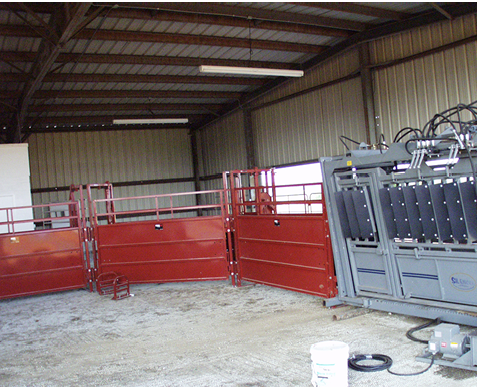
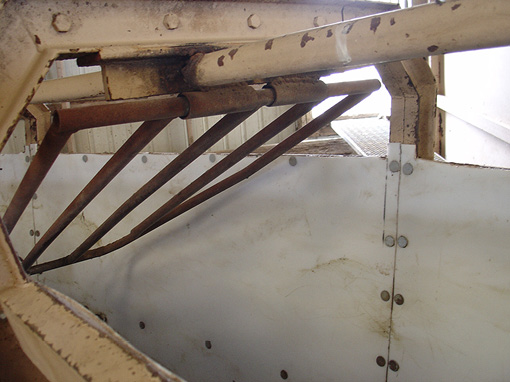
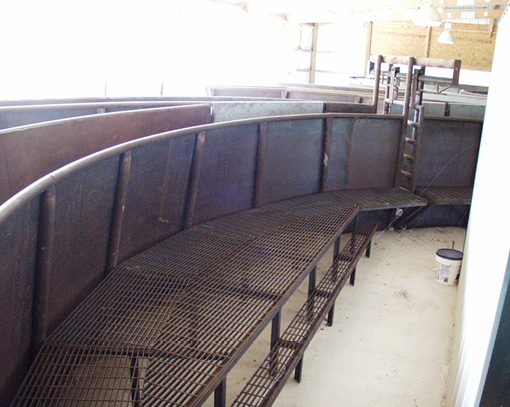
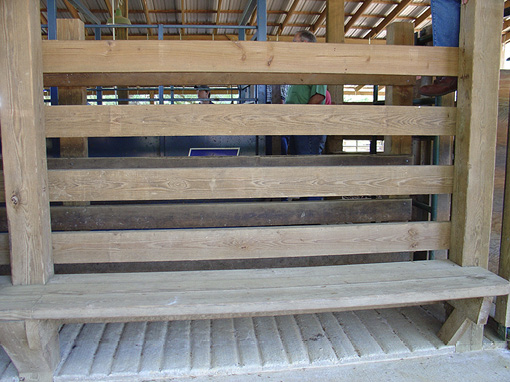
Figure 4. Catwalks along outside of alleys.
A double-loading alley provides two single-file lines of cattle ready to be loaded into a common squeeze chute. Having two alleys maintains constant flow at the chute because cattle are ready on one side even if the other side is vacant. Due to higher initial costs, a double-loading alley is most appropriate for facilities that handle large numbers of cattle year-round (marketing facilities, large stocker operations, and large feedlots).
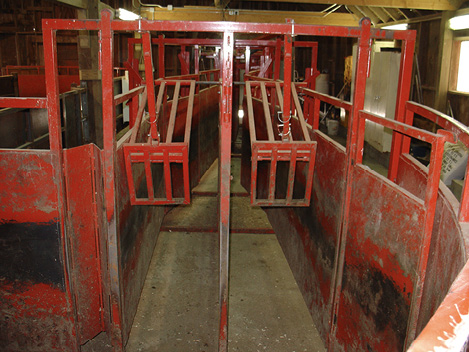
Slider Gates
Slider gates in alleys act similarly to backstops by keeping cattle from backing up. They are very effective at staging individuals for maintained flow, but they are usually manually operated and require attention from a handler. They are most effectively used at the back of permanent scales or between the chute and palpation cage. Use care when operating sliding gates to avoid being struck by a gate in motion.
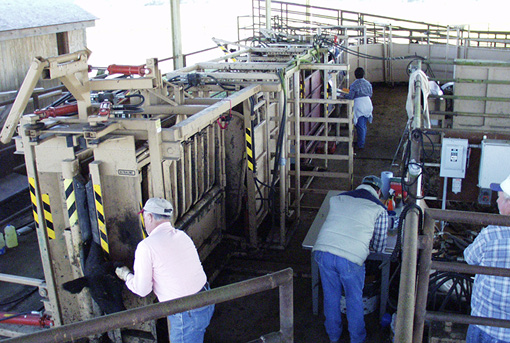
Squeeze Chute
A squeeze chute with a head catch ensures safety for both cattle and handler. The head catch keeps the animal from backing up and allows access to the head and neck. Squeezing the sides of the chute limits movement of the cattle while they are being worked. It also provides a calming effect for the cattle and makes them feel more secure, leading to decreased movement. Squeeze chutes vary in design but often allow an animal to exit the chute not only from forward movement but also to the side via a hinged side panel if needed. Squeeze chutes have multiple levers or pulls that function to open, close, and squeeze different parts of the chute. This allows one person to operate the squeeze chute while other handlers move cattle into the chute. Chutes without the body squeeze function but with a head squeeze and removable sides are available for grooming or fitting cattle.
Although producers commonly build many other components of cattle handling facilities, squeeze chutes are almost always purchased from a selection of commercially available products. The more involved designs and features of squeeze chutes means that more moving parts must interact in this particular component of cattle handling facilities. Because of this, it is generally more practical and preferable to buy a ready-to-use squeeze chute than to try to build one.
Commercial squeeze chutes effectively restrain cattle, improve processing efficiency, and increase overall safety. One of the most important considerations in buying or building a working chute is the ability to give all injections in the neck. Make sure that this can be done quickly and, most importantly, in a way that does not put the handler’s arm in danger of being injured.
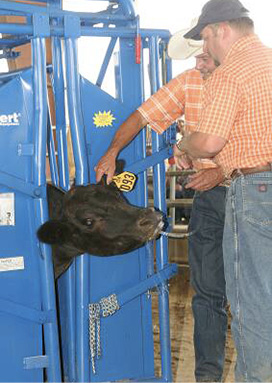
Palpation Cage
A palpation cage is an extension of the squeeze chute with a door that swings across the alley. It allows easy and safe access to the rear of cattle restrained in the squeeze chute. It is especially important for cow-calf operations where pregnancy diagnosis and other reproductive management techniques are frequently used.
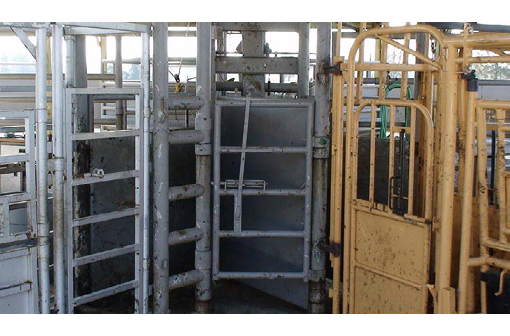
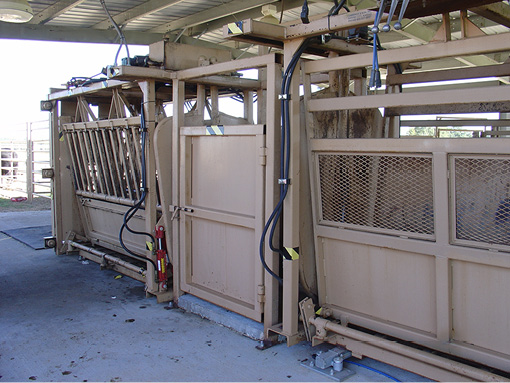
Figure 8. Palpation cages.
Sorting Pens
Having sorting pens situated in front of the working chute decreases labor by allowing cattle to be individually directed to the appropriate management group. Sorting pens are sometimes called holding pens because they are designed to hold cattle before and after processing through the chute. If cattle are not to be worked immediately, holding pens need sources of drinking water for cattle and additional space.
The number of cattle that will comfortably fit in a pen is based on the width and length of the pen and the size of the cattle. In general, cattle need 14 to 20 square feet of space each (see Table 1). Pen areas should be roughly tripled when holding animals for extended periods, such as overnight. Table 2 presents example holding pen dimensions to provide 20 square feet of space per animal.
Set up pens off of a lane leaving the chute so that the cattle can be sorted immediately after processing. Make sure the gates hinge on the proper side so they will swing in the desired direction to move cattle directly into pens. The number and sizes of sorting pens needed depends on the number and sizes of cattle to be handled. Larger operations may need more sorting pens than smaller operations.

|
Animal weight, lb |
|||
|---|---|---|---|
|
Time in holding pen |
< 600 |
600–1,200 |
> 1,200 (and cow-calf pairs) |
|
Worked immediately |
14 ft2 |
17 ft2 |
20 ft2 |
|
Held overnight |
45 ft2 |
50 ft2 |
60 ft2 |
Adapted from R. Borg et al. 2002. CAN-723. Alberta Agriculture, Food, and Rural Development. Edmonton, Alberta, Canada.
|
Number of animals |
||||
|---|---|---|---|---|
|
Holding pen size |
30 |
40 |
50 |
60 |
|
Pen area |
600 ft2 |
800 ft2 |
1000 ft2 |
1200 ft2 |
|
Example dimensions |
12’ x 50’ 20’ x 30’ |
12’ x 70’ 20’ x 40’ |
12’ x 85’ 20’ x 50’ |
12’ x 100’ 20’ x 60’ |
Flooring
Flooring is a design issue that is often overlooked but can create safety issues for both cattle and handlers if not done correctly. Dirt floors are the most common, but in certain environments, dirt floors readily become dusty or muddy. Mud can harbor infectious diseases, and dust can aggravate the respiratory system, both leading to an increased incidence of disease. Concrete flooring is a good alternative to dirt floors but must be textured to reduce slipping. Cattle that slip on smooth concrete flooring can be severely injured and pose an injury risk to the people handling them. Concrete can be textured as it is poured or after it is poured. Planning ahead will save money and time because it is easier and cheaper to texture concrete while it is being poured.
It is also useful to place non-slip mats in key areas, such as in front of the chute exit, to improve cattle traction. Mats should be heavy enough not to slide or fold readily as cattle trample over them. Textured, heavy-duty rubber mats are easy to clean and provide a durable, non-slip surface that can be moved to various flooring areas as needed.
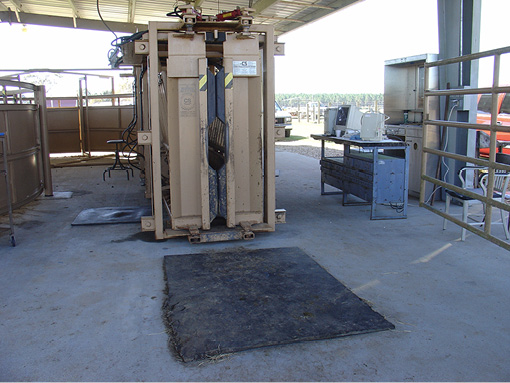
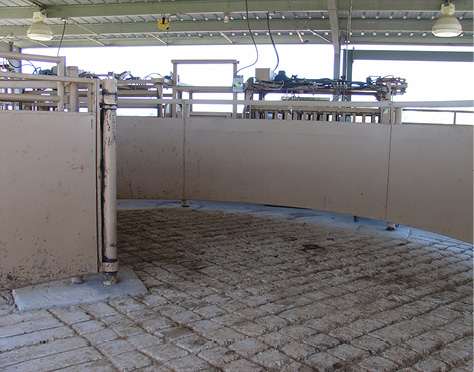
Loading Ramps
Loading and unloading ramps are used to move cattle from ground-based handling facilities to trailers for transportation and vice versa. They can be permanent or portable. Ramp heights may need to differ depending on the type of trailers used. Maintaining loading ramps of different heights or an adjustable-height loading ramp can facilitate a variety of transportation options. If tractor-trailers are to be unloaded, these ramps should be single file (30 inches for mature cattle) to accommodate the 30-inch-wide rear doors standard on most US tractor-trailers. Ramps can be narrowed to less than 30 inches when only calves will be handled. To avoid cattle striking the sides of the trailer during loading, ramps should not be wider than the trailer opening. Self-aligning dock bumpers and telescoping ramp panels are useful for blocking gaps from misaligned trucks. Injuries can occur if unloading ramps are too steep. Target a loading ramp height of 20 degrees for permanent ramps and 25 degrees for adjustable ramps. Grooved stair steps are recommended for concrete ramps. Design steps to be 4 inches high and 12 inches deep. Table 3 outlines recommended loading chute dimensions.
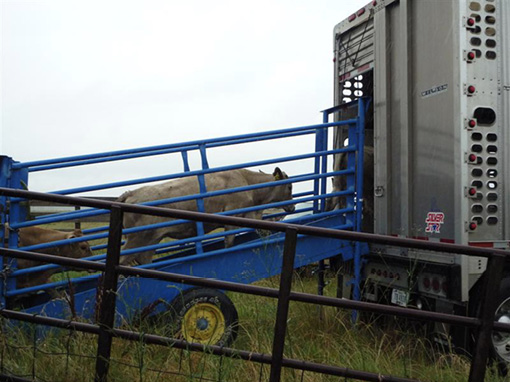
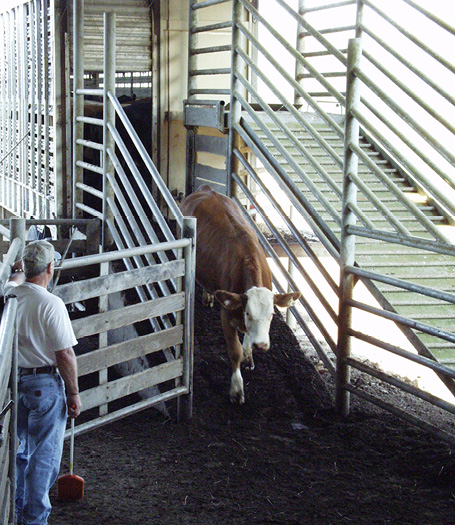
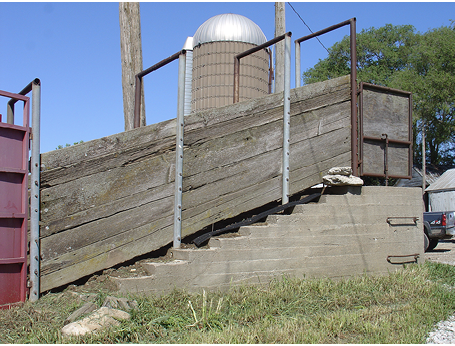
Figure 13. Permanently fixed loading ramps.
|
Loading chute aspect |
Dimensions |
|---|---|
|
Width |
26 to 30 in |
|
Length (minimum) |
12 ft |
|
Rise |
3.5 in/ft |
|
Ramp height |
|
|
Stock trailer |
15 in |
|
Pickup truck |
28 in |
|
Stock truck |
40 in |
|
Tractor-trailer |
48 in |
|
Double-deck trailer |
100 in |
Adapted from Iowa State University. 1987. Midwest Service Plan. Beef Housing and Equipment Handbook. MWP S-6. Iowa State Univ. Ames, IA.
Working Tables
Working tables next to the squeeze chute and head gate where cattle are restrained are useful for organizing supplies. Tables provide a surface for preparing animal health products to administer, marking ear tags, writing down records, and completing other organizational tasks that take place during cattle handling. Use tables with drawers or cabinets to store extra supplies that might be needed during a cattle handling event. Be sure to return any supplies that need temperature-controlled or locked storage to appropriate locations after cattle handling is completed.
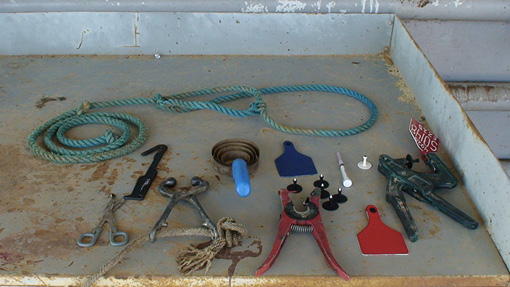
Utilities
Incorporating utilities such as electricity and water into cattle handling facilities can greatly increase their functionality. Electricity can be used to provide lighting to extend effective cattle handling hours and improve visibility. Electronic scales, clippers, and ultrasound machines are just some of the devices that may need electricity sources on site. Battery-powered devices can be an option, as well, but have limited battery life before needing recharging. Fresh water supplies at cattle handling facilities are useful for cleaning the facilities and supplying penned cattle with water during extended stays or hot periods.

Scales
Capturing cattle weight is important for herd performance programs, genetic improvement efforts, nutritional management, and animal health product dosing. Integrating scales into the alley improves efficiency by letting a handler record cattle weights while other handlers are performing management practices in the squeeze chute. This can be accomplished by using permanent scales behind the chute, load bars under the chute, or portable weigh pans placed in the alley floor.
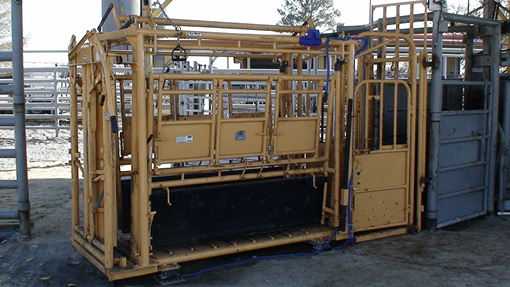
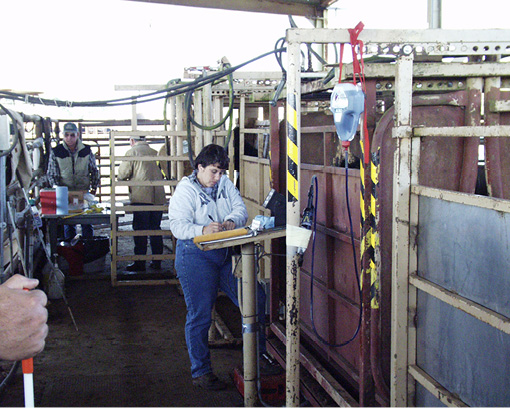
Fences
Fences provide the boundaries of pens and paddocks. Fencing construction and management recommendations are provided in Extension Publication 2538 Livestock Fencing Systems for Pasture Management.
Facility Design Considerations
Size and space requirements for cattle handling facilities vary depending upon the size of cattle to be handled. Table 4 presents general size and space recommendations for various components of cattle handling facilities.
Cattle handling facility location should consider existing or planned fence placement, site drainage, proximity to neighbors (for courtesy and privacy reasons), proximity to utilities, ease of access by vehicles and from pastures, and amount of acreage and cattle capacity served. In some situations, multiple cattle handling sites are needed on one operation to efficiently and effectively accommodate cattle volume and pasture layout. Select a site that will accommodate possible future expansion needs.
Although most cattle handling facilities are fixed in their location, it is possible to use portable facilities. Portable corral systems come in a variety of designs and can be assembled, disassembled, and relocated as needed. Sections can be added or removed to create different configurations and dimensions. If portable facilities are not of sufficient gauge materials and adequately secured to the ground, then large or excitable cattle may be able to bend or move the facilities. Consider attaching portable facility components to permanent posts to provide additional stability to the structure.
Many amenities can be added to a handling facility to improve flow and increase efficiency. However, most require extra investment and might not be justified for the original objectives. Again, assess the intended uses of the facilities. Consider factors such as the need to have cattle near handling facilities during calving seasons and the need to have tractor-trailer access to facilities for loading and unloading. Also, determine how the location and design of facilities will fit with biosecurity plans.
Locating handling facilities inside a permanent barn or portable structure allows producers to work cattle during inclement weather and ensures that management practices are performed in a timely and low-stress manner. If a permanent barn structure is used, incorporate skylights to improve visibility and safety while decreasing lighting requirements during daylight hours.
Use a single color in handling facilities to minimize cattle balking at color contrasts. Do not paint facilities black or another very dark color because these will absorb too much heat. Also, avoid using white or very light colors that will reflect too much light. Manage lighting to avoid stark contrasts, shadows, and glares.
Safety of the animals and handlers is the primary consideration in developing handling facilities. No matter how efficiently a facility functions, it is unacceptable if design flaws lead to injuries in handlers or animals. Design facilities to avoid protrusions or sharp edges that might cause abrasions or lacerations. Make sure gaps and openings in facility features do not lend themselves to body parts becoming trapped, which could lead to broken bones or choking. Also ensure that safety escapes for handlers are strategically located throughout the facilities.


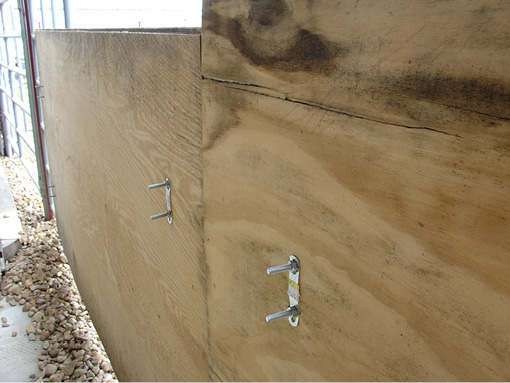
|
Component |
Size/space item |
Dimensions by cattle weight |
||
|---|---|---|---|---|
|
< 600 lb |
600–1,200 lb |
> 1,200 lb |
||
|
Holding pen |
Space per head, ft2 |
14 |
17 |
20 |
|
Pen fence height, in |
60 |
60 |
60 |
|
|
Post spacing, ft |
8 |
8 |
8 |
|
|
Post depth in ground, in |
30 |
30 |
30 |
|
|
Crowding pen |
Space per head, ft2 |
6 |
10 |
12 |
|
Post spacing, ft |
4–6 |
4–6 |
4–6 |
|
|
Solid wall height, in |
45 |
50 |
50–60 |
|
|
Working chute, straight sides |
Width, in |
18 |
22 |
28 |
|
Length, minimum ft |
20 |
20 |
20 |
|
|
Working chute, sloped sides |
Width at 4-ft height, in |
20 |
24 |
28 |
|
Width inside at bottom, in |
15 |
16 |
18 |
|
|
Minimum length, ft |
20 |
20 |
20 |
|
|
Working chute fence |
Post spacing, ft |
7 |
7 |
7 |
|
Post depth in ground, in |
36–48 |
36–48 |
36–48 |
|
|
Solid wall height, in |
54–60 |
54–60 |
60 |
|
|
Top rail height for gentle cattle, in |
54–60 |
60 |
60 |
|
|
Top rail height for aggressive cattle, in |
60–72 |
60–72 |
60–72 |
|
|
Holding/squeeze chute |
Height, in |
45 |
50 |
50 |
|
Straight sides width, in |
18 |
22 |
28 |
|
|
V-shaped sides width at bottom, in |
6–8 |
8–12 |
14–16 |
|
|
Length including head gate, ft |
5 |
5–8 |
5–8 |
|
|
Loading chute |
Width, in |
26 |
26 |
26–30 |
|
Minimum length, ft |
12 |
12 |
12 |
|
|
Maximum rise, in/ft |
3.5 |
3.5 |
3.5 |
|
|
Spacing of 1-in x 2-in cleats, in |
8 |
8 |
8 |
|
|
Trailer ramp height |
15 |
15 |
15 |
|
|
Pickup truck ramp height |
28 |
28 |
28 |
|
|
Large truck ramp height |
40 |
40 |
40 |
|
|
Tractor-trailer ramp height |
48 |
48 |
48 |
|
|
Double-deck trailer ramp height |
100 |
100 |
100 |
|
Adapted from J. R. Bicudo et al. 2002.Cattle Handling Facilities: Planning, Components, & Layouts. Univ. KY, Coop. Ext. Serv., Lexington, KY.
Construction Considerations
Commercially available cattle handling facility components that just need incorporation into a facility layout are one option for producers. Cattle operations can also construct facilities from their own designs and materials. Highway guard rails, railroad timbers, rough sawn lumber, and recycled grain bin panels are some examples of materials that can be used.
Start by drawing a basic facilities layout including dimensions. Then physically measure and mark outside perimeters at the prospective construction site. Check and recheck measurements to ensure accuracy. Use flags, stakes, chalk, or paint to outline the facilities design on the site. Then adjust the location or design of the layout as appropriate before finalizing construction plans.
Begin the construction sequence by doing any dirt work needed to raise or level the construction site. Proceed with setting the sturdy hinge post for the crowding pen gate. Then hang the crowding pen gate. Next, set the posts for the crowding pen wall using the gate as a guide. Allow adequate space for the pen panels between the gate edge and the inside edge of the posts. Finish setting all posts in the crowding pen area including the opening into the alley. Once the posts are set, a concrete slab or other surface can be applied throughout the facility. Proceed in a logical construction sequence for the rest of the main cattle handling area, holding pens, and other facilities. Work off of the crowding pen site to minimize the risk of measurement errors and the various facility components not joining together properly.
Facilities Use
Before moving cattle through a handling facility, inspect it thoroughly. Do this before the first use and also routinely before later uses. Facilities require repair and upkeep over time to remain safe, functional, and efficient. Walk the paths that cattle will walk. Make sure there are no protrusions, gaps, obstacles, damage, wear, or other features that might risk injury to cattle or handlers or cause cattle to balk. Be sure gates are securely latched where needed and adjustable components of facilities are set for the size of cattle to be worked next.
Familiarize handlers with facilities features and squeeze chute operation. Use only personnel who are properly trained in cattle handling. Provide adequate oversight of cattle handling, including corrective actions as needed.
For more information on facilities for beef cattle or other beef cattle production topics, contact your local MSU Extension office or visit http://extension.msstate.edu/agriculture/livestock/beef.
References
Bicudo, J. R., S. McNeill, L. Turner, R. Burris, and J. Anderson. 2002. Cattle Handling Facilities: Planning, Components, and Layouts. AEN-82. University of Kentucky, Cooperative Extension Service, Lexington, KY.
Borg, R., S. Tucker, and R. Smith. 2002. Corrals for Handling Beef Cattle. CAN-723. Alberta Agriculture, Food, and Rural Development. Edmonton, Alberta, Canada.
Grandin, T., and M. Deesing. 2008. Humane Livestock Handling. Storey Publishing, North Adams, MA.
The information given here is for educational purposes only. References to commercial products, trade names, or suppliers are made with the understanding that no endorsement is implied and that no discrimination against other products or suppliers is intended.
Publication 2787 (POD-07-22)
Revised by Brandi B. Karisch, PhD, Associate Extension/Research Professor, Animal and Dairy Sciences; from an earlier version by Jane A. Parish, PhD, Professor and Head, North Mississippi Research and Extension Center; and Rhonda C. Vann, PhD, Research Professor, Animal and Dairy Sciences.
The Mississippi State University Extension Service is working to ensure all web content is accessible to all users. If you need assistance accessing any of our content, please email the webteam or call 662-325-2262.





